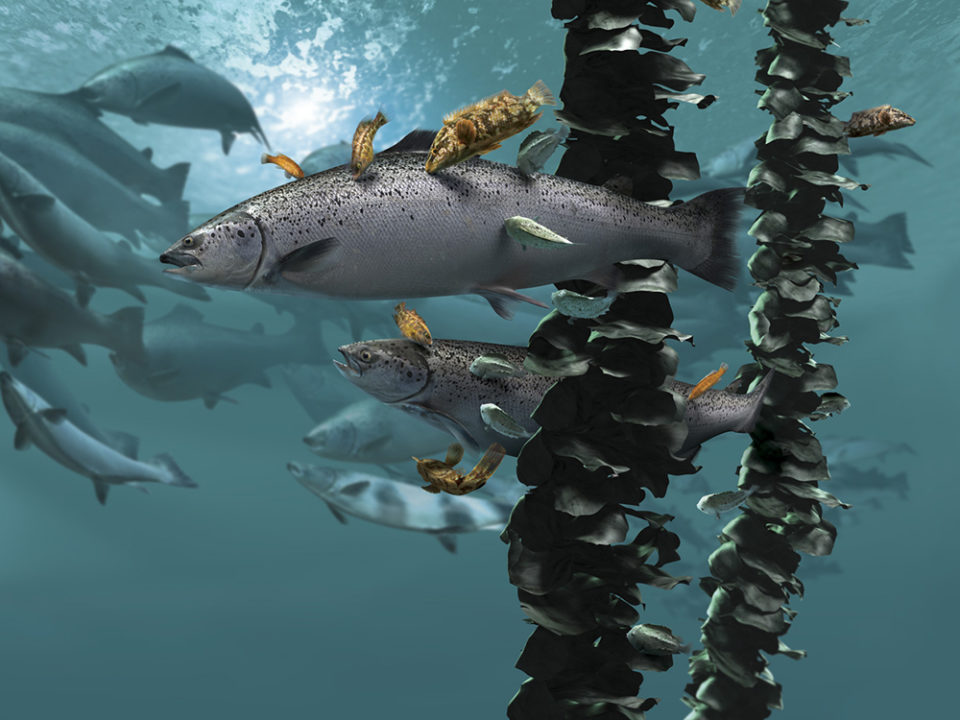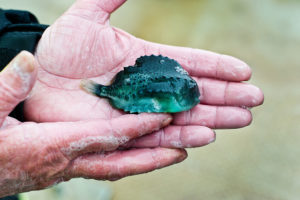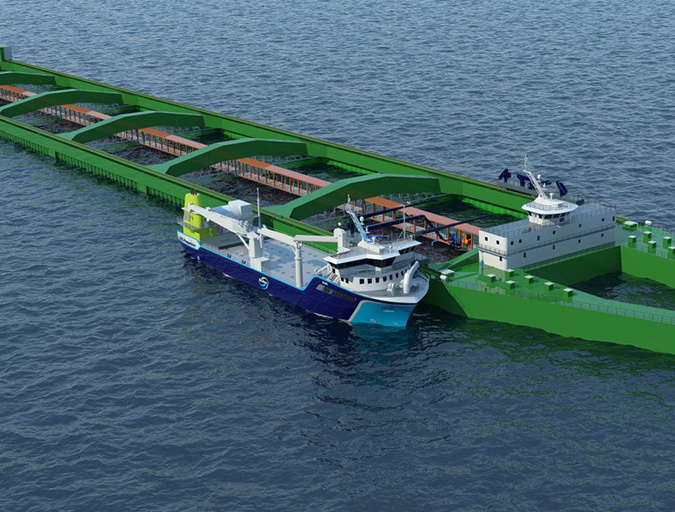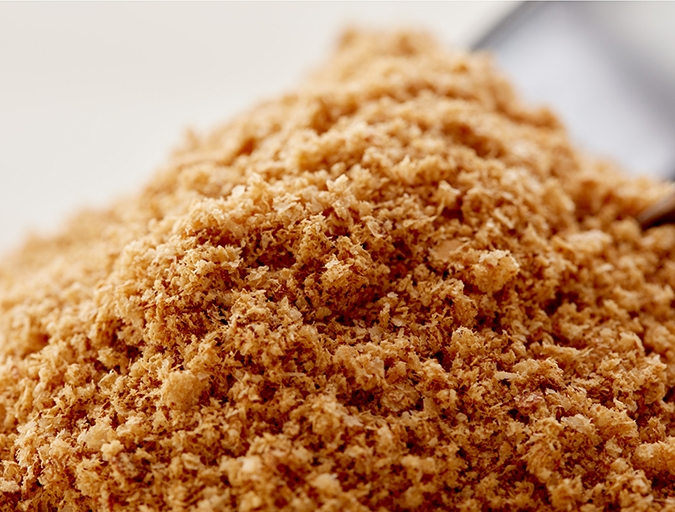H2O2 among the chemical sea lice treatments waning in favor of biological, mechanical measures

Two years ago, Marine Harvest used 8 million liters of hydrogen peroxide to treat sea lice and amoebic gill disease at its salmon farms along the coast of Scotland.
2015 marked peak usage of chemicals and medicines, said Ben Hadfield, COO, fish feed and managing director of Marine Harvest Scotland.
The following year, total usage dropped to 6 million liters as the company invested in non-chemical controls like cleaner fish – wrasse and the aptly named lumpsucker fish that swim with the salmon, plucking the sea lice that adhere to the fish’s skin to feed.
Hadfield pointed to two indicators that Marine Harvest’s decision to back away from chemicals and medicines was the right call: The average harvest weight of salmon farmed in Scotland is up to 6 kilograms, compared to 3.6 kilograms a year ago.
And, said Hadfield, sea lice levels for the first few months of 2017 are about one-fifth what they were at this time in 2016.
“The [sea lice] levels clearly increased in Scotland and it takes time and effort to bring them down,” said Hadfield. “We’ve spent the last 12 months doing that and we’re actually in good position on sea lice control.”
Over-reliance on medical and chemical controls, along with warming waters, led to the surge in sea lice in the last several years, he added. In 2015, Scottish fish farms used a total of 19.56 million liters of hydrogen peroxide, according to the Scottish Environment Protection Agency.
But it does have its downsides: Too much can hurt the fish and, like other chemical and medicinal treatments (see Table 1), it is losing effectiveness.
Duchene, Table 1
| Chemical | Amount used (grams): 2014 | Amount used (grams): 2015 | Amount used (grams): 2016 |
|---|---|---|---|
| Deltamethrin | 17,471 | 12,356 | 8,292 |
| Cypermethrin | 0 | 0 | 0 |
| Azamethiphos | 253,287 | 281,785 | 569,794 |
| Teflubenzuron | 0 | 0 | 0 |
| Emamectin benzoate | 65,600 | 71,160 | 57,528 |
Growing resistance to chemicals
An industry specialist’s 2015 study indicates salmon farmers may have little choice but to look beyond chemical and medicinal treatments.
“Chemical classes used for sea lice control include organophosphates, pyrethroids, peroxide (as bath treatments), avermectins, and benzoylureas (as in-feed treatments),” wrote Myron Roth, aquaculture and seafood industry specialist for the British Columbia Ministry of Agriculture, whose review was published in International Animal Health Journal in March 2015.
Chemicals from each class were all either in development or in use by the mid-1990s, wrote Roth, but were not all available in every region at the same time, preventing product rotation.
“Resistance is now widespread and found in almost all regions to all chemical classes of compounds with the exception of benzyolureas — which are difficult to assess,” wrote Roth. “In fact, we now have strains of lice that are resistant to several classes of compounds.”
How H2O2 works
There is a bottle of hydrogen peroxide from the drugstore under most people’s bathroom sinks or medicine cabinets. It’s also found inside the bodies of all animals. It is part of the immune response: Certain cells produce it to respond to bacteria and it indicates white blood cells are fighting an infection at the site of a wound.
But if hydrogen peroxide levels are too high, they may hurt instead of help by damaging cell DNA.
That’s the case with fish, too.
Salmon farmers have used hydrogen peroxide for decades to combat their No. 1 enemy — sea lice — and also in the last several years for amoebic gill disease. While considered environmentally safe, the chemical can hurt the fish if the concentrations are too high and, due to overuse, it’s losing its effectiveness against sea lice.
Hydrogen peroxide, diluted with seawater, weakens the lice, detaching them from the salmon.
We had to respond quite quickly when amoebic gill disease appeared on the scene in 2012, so hydrogen peroxide was the treatment of choice.
Hydrogen peroxide reacts with catalyse enzymes in the tissues of the sea lice and breaks down into its water and oxygen components, said Dr. Ian Bricknell, professor of aquaculture biology at the University of Maine’s Aquaculture Research Institute. “All the catalyse in that animal starts making water and oxygen. Gas bubbles form within the louse and damage it,” said Bricknell.
“When used properly, hydrogen peroxide is a very good treatment,” he said, adding he has no concerns that the chemical will harm the surrounding environment, provided farmers are using it in well boats, then treating the residual water with charcoal before returning it to the sea.
Anne Anderson, head of regulatory services for the north region at the Scottish Environmental Protection Agency, said in an email that SEPA considers the safe use of hydrogen peroxide at fish farms as “a minimal environmental risk.”
“While hydrogen peroxide is included in the license documentation for marine cage fish farms, SEPA does not impose numeric limits on the use of the chemical,” she said. “This is because the agency recognizes that hydrogen peroxide rapidly decomposes without leaving persistent residues. When used appropriately at a fish farm, hydrogen peroxide will pose no significant threat to marine life [outside of] the immediate vicinity of the farm cages.”
A slim margin of safety
But like hydrogen peroxide in human tissue, too much of a good thing turns bad. Using hydrogen peroxide baths to treat salmon for sea lice requires veterinary supervision and careful attention to time, concentration and temperature.
“There is a relatively fine line between a successful treatment and a treatment that can cause damage to the fish,” said Marine Harvest’s Hadfield.
Researchers at the University of Bergen in Norway, building on earlier work, found that hydrogen peroxide may harm the fish’s innate immunity with results they presented at Aquaculture Europe 2016 in Edinburgh, Scotland in September.
Sea lice graze on the fish’s skin and mucosal tissue, leaving the fish prone to secondary infections and osmotic stress – once sea lice chew a hole in the fish’s protective skin, the fish loses water than normal, which causes dehydration and demands they use more energy to stay healthy. These all lead to death. The researchers sampled fish on a commercial farm delousing fish with hydrogen peroxide. “The gills were significantly affected and weakened after the treatment, showing a more sensitive response than the other studied organs,” wrote two of the researchers, Ph.D. student Imelda Rantty and Dr. Karin Pittman, a University of Bergen professor and board member at Quantidoc AS. The results indicate hydrogen peroxide can disrupt the fish’s gills and cause moderate to severe lesions.
“The damage to the gill seems to be the reason for the increased mortality observed in groups treated with high concentrations of hydrogen peroxide (e.g., 200 and 400 ppm),” said Rantty. “The recommended treatment for delousing at a concentration of 1,500 ppm hydrogen peroxide for 20 minutes is able to remove from 85 to 100 percent of the mobile stages of sea lice. It is recommended that consequent delousing should not be done for at least two to three weeks after previous delousing. Biological observation such as feeding rate should also be noted. Decreased feeding an be a sign of irritated esophagus.”
Reduced sensitivity
In Norway, fish farmers used hydrogen peroxide as a delousing agent for several years in the mid-1990s – until new chemicals with larger safety margins arrived. When sea lice became sensitive, hydrogen peroxide made a comeback to the Norwegian market in 2009, according to a study into sea lice sensitivity to hydrogen peroxide from scientists at the Sea Lice Research Centre in Oslo, Norway, and Aqua Kompetanse AS in Flatanger, Norway, published in February 2015 in Aquaculture Reports.
“Reduced sensitivity in L. salmonis, due to extensive use of the chemical as a delousing agent, was first reported from Scotland in 1999, seven years after H2O2 treatment was introduced to the Scottish market,” wrote Kari Olli Helgesen and colleagues.
In 2010 and 2011, hydrogen peroxide returned as the mainstay treatment, said Hadfield. The next year marked the appearance of amoebic gill disease – typically expressed by lesions on the gills caused by a microscopic amoeba.
“We had to respond quite quickly when amoebic gill disease appeared on the scene in 2012, so hydrogen peroxide was the treatment of choice,” said Hadfield.
But hydrogen peroxide has become less effective over time. Within a few years, he said, the concentrations of hydrogen peroxide required to remove sea lice edged up toward 2,000 parts per million from 1,000 to 1,500 ppm.
Push to bio and mechanical treatments

The waning effectiveness of hydrogen peroxide led to the push for new treatments – like the Thermolicer, a machine that treats salmon for lice by passing them through a 25- to 30-second loop including a bath in seawater heated to 30 to 34 degrees-C (86 to 93 degrees-F), which forces the lice to detach from the fish. The device treats up to 80 tons of fish per hour. Marine Harvest said it has treated hundreds of thousands of tons of salmon in Norway and Scotland using the machine, which has been tested over nine years and is recommended by the Norwegian Veterinary Institute.
A problem with the device led to the loss of 95,400 fish last summer at the Marine Harvest farm on Isle of Skye, Scotland, as reported in The Telegraph in November. A reported 60,000 fish off the Isle of Harris were lost in September due to hydrogen peroxide treatment for amoebic gill disease and 20,000 fish were killed at Loch Greshornish farm due to a chemical treatment.
Loch Duart, which operates nine farm areas along the Scottish coast, is also increasing non-medicinal controls for sea lice like the cleaner fish.
“I do believe the industry has gone through a period of looking for a medicinal silver bullet and the revelation to us is you shouldn’t be looking for a silver bullet,” said Andy Bing, sales manager of Loch Duart. “You should be looking for a suite of non-medicinal controls which actually get you where you want to go, which is control of the sea lice.”
Loch Duart continues to use hydrogen peroxide as a treatment for amoebic gill disease, but for sea lice the company is refining its use of wrasse and lumpfish. “They learn that a sea louse is a food on the salmon, and the salmon learn to allow them to approach and take it,” said Bing.
At the Marine Harvest sites in Scotland, the bollan wrasse are active in summer and lumpsucker in the winter, so the two species are used in combination. The cleaner fish make up about 5 percent of the fish in the pens.
Knowledge of cleaner fish dates to the 1980s and 1990s, said Hadfield.
“It was shelved because the medicines that came in were so effective that cleaner fish development wasn’t needed,” said Hadfield. “In hindsight it would have been smart for industry to keep developing it because we’ve had to do a lot of catchup recently on cleaner fish.”
Author
-

Lisa Duchene
Lisa Duchene is a freelance conservation science writer, editor and communications consultant based in central Pennsylvania. She has written about the marine environment for more than two decades.
Tagged With
Related Posts

Innovation & Investment
Thinking outside the cage: Avant-garde aquaculture in Norway
Salmon farming in Norway is poised for an innovation boom. The biggest players are putting cutting technology in the water to solve some of the industry’s most persistent problems, such as sea lice, fish escape and waste management.

Health & Welfare
Chem-free fixes emerging in sea lice saga
Salmon farmers, using emerging technologies, are exploring new methods of sea lice mitigation in an effort to overcome one of the industry’s most persistent problems. New chemical-free innovations show an industry eager to adapt and adopt environmentally safe practices.

Aquafeeds
Bridging the omega-3 gap with methane, microalgae
Innovation is leading to new ingredient options for renewable sources of omega-3 fatty acids. But Replicating long chain fatty acids is a tall order, Advocate contributor Lisa Duchene discovered.

Aquafeeds
Omega-3 levels fall in farmed salmon but it’s still a top source
Reformulating aquaculture feeds, an industrywide initiative to reduce dependence on wild fish, has changed farmed salmon’s nutritional profile, as BBC News reported recently. The researchers on whose work the report was based say of course it has, yet it remains one of the best sources for these crucial fatty acids.

